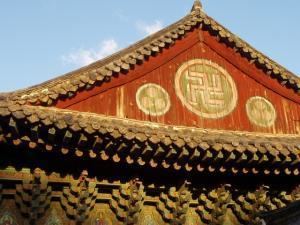 | ||
The term sauwastika (or sauvastika) (as a character: 卍) is sometimes used to distinguish the left-facing from the right-facing swastika symbol, a meaning which developed in 19th century scholarship.
Contents
The left-facing variant is favoured in Bön and Gurung Dharma; it is called yungdrung in Bon and Gurung Yantra in Gurung Dharma. Both the right-facing and left-facing variants are employed in Hinduism and Buddhism; however, the left-facing is more commonly used in Buddhism than Hinduism and the right-facing is more commonly used in Hinduism than Buddhism.
In Buddhism the left-facing sauwastika imprinted on the chest, feet, palms of Buddha and also the first of the 65 auspicious symbols on the footprint of the Buddha. In Hinduism the left-facing sauwastika is associated with esoteric tantric practices and often stands for Goddess Kali.
Etymology
Sanskrit sauvastika is the vṛddhi of svastika, attested as an adjective meaning "benedictive, salutatory". The connection to a "reversed" svastika is probably first made by Eugène Burnouf in 1852, and taken up by Schliemann in Ilios (1880), based on a letter from Max Müller, who is in turn quoting Burnouf. The term sauwastika is used in the sense of "backwards swastika" by Eugène Goblet d'Alviella (1894): "In India it [the gammadion] bears the name of swastika, when its arms are bent towards the right, and sauwastika when they are turned in the other direction."
The term has been misspelled as suavastika, a term attributed to Max Müller by Wilson (1896). Wilson finds that "The 'suavastika' which Max Müller names and believes was applied to the swastika sign, with the ends bent to the left [...] seems not to be reported with that meaning by any other author except Burnouf."
Claims of a distinction in Indian religions
Eugene Burnouf, the first Western expert on Buddhism, stated in his book Lotus de la bonne loi (1852) that the sauvastika was a Buddhist variant of the svastika.
When Heinrich Schliemann discovered swastika motifs in Troy, he wrote to the Indologist Max Müller, who, quoting Burnouf, confirmed this distinction, adding that "the svastika was originally a symbol of the sun, perhaps of the vernal sun as opposed to the autumnal sun, the sauvastika, and, therefore, a natural symbol of light, life, health, peace and wealth." The letter was published in Schliemann's book Ilios (1880):
“In the footprints of Buddha the Buddhists recognize no less than sixty-five auspicious signs, the first of them being the Svastika [...]” (Eugene Burnouf, Lotus de la bonne loi, p. 625); “the fourth is the sauvastika [sic], or that with the arms turned to the left.”
The term sauvastika thus cannot be confirmed as authentic and is probably due to Burnouf (1852). Notions that sauwastikas are considered "evil" or inauspicious versions of the auspicious swastika in Indian religions have even less substance, since even Burnouf counts the svastika and the sauvastika equally among the "sixty-five auspicious signs".
D'Alviella (1894) voices doubts about the distinction:
Would it not be simpler to admit that the direction of the branches is of secondary importance in the symbolism of the gammadion? When it is desired to symbolize the progress of the sun, namely, its faculty of translation through space, rather than the direction in which it turns, little attention will have been paid to the direction given to the rays. (p. 68)
Although the more common form is the right-facing swastika, the symbol is used in both orientations for the sake of balance in Hinduism. Buddhists almost always use the left-facing swastika.
Use
Sauwastika was a favorite symbol of the last Russian Empress Alexandra Feodorovna. She put this sign everywhere for good luck. In particular, she drew it with a pencil on the wall, at the window opening, and on the wallpaper above the bed of her son Tsarevich Alexei Nikolaevich in Ipatiev House, where the murdered Emperor's family spent the last days of their lives.
